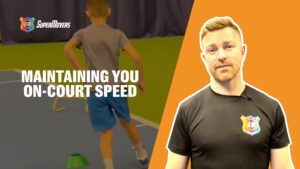The Shapes of a Grand Slam Champion
The Shapes of a Grand Slam Champion
We had the pleasure of watching Emma Raducanu successfully make her way to the US Open final via qualifying and win the tournament without even dropping a set! But as well as the lights-out tennis, we got to witness a tennis athlete in action. I am going to take this opportunity to say congratulations to her S&C coach, who is a good friend, on developing a truly awesome athlete who has proved she can take on the world.
But here at Tennis SuperMovers, we look at players’ performances with a slight twist. Many tennis coaches focus on the technical and tactical elements of tennis, be this the professionals or the players they work with. When observing the pictures of players in action below, a tennis coach may focus mainly the racket work:
But what we would like for everyone – player, tennis coach, physical coach and parent – is to see the underpinning physical shapes (highlighted by the yellow lines) that are needed to create the specific movements, we call these the Integrated Tennis Shapes.
To give a couple of examples of fundamental exercises that underpin tennis specific movement, see the lunge and squat pattern below:


The Integrated Tennis Shapes have three key elements to enable success:
- Observation
- Communication
- Intervention
Observation – The ability for everyone to observe the player’s movement through a ‘common lens’. That the most common shapes are understood and can be seen within the footwork patterns. One of the easiest ways to enable this is to video the player in action, then you can slow down the video and freeze-frame the critical moments.
The other key element to the observation is understanding at which point the potential issues arising – is it the split step? Is it the footwork to the ball? Is it the ability to slow down and be on balance for the hit? Or is it the return footwork?
Communication – One common issue I come across is the ability of the coach and physical trainer to speak a ‘common language’. There are certain tennis specific models that have an extensive list of footwork patterns; for me, someone who has aimed to simply the process is Louis Cayer whose ‘footwork cycle’ consists of – Start, Move, Hit, Recover – simple! See the picture below for the variable within each section:

The second communication issue which can arise is the physical trainer speaking in a more complicated sport science language than is needed, for me this is a sign of a coach with less experience, or just someone who is trying to sound clever. I challenge myself to always to follow the KISS principle – Keep it Simple Stupid. That’s not to say anyone involved is stupid, more challenging yourself to articulate your message so simple a child could understand it…someone much cleverer than me said that this is important…

Intervention – Finally, it is the agreed process of intervention, that is needed to help correct any issues which are highlighted via the observation. This can include who is accountable for the work required, how long the process will take, when precisely will the work take place and how will it be measured. The Tennis SuperMovers curriculum is designed in a way that whatever issue a player may be having, there is a drill or series of drills that will help. This is achieved by focusing sessions on actual on-court movement. We design sessions based on Forward and Back, Side to Side and Multi-Directional. If you were to think of the movement being a jigsaw, then the exercises within the programme are the individual pieces that can be worked upon. For more on Tennis SuperMovers, click here.
Don’t miss next week’s blog where I will share with you the key exercises which we use to help rehearse the key tennis shapes.
Have a great week!









